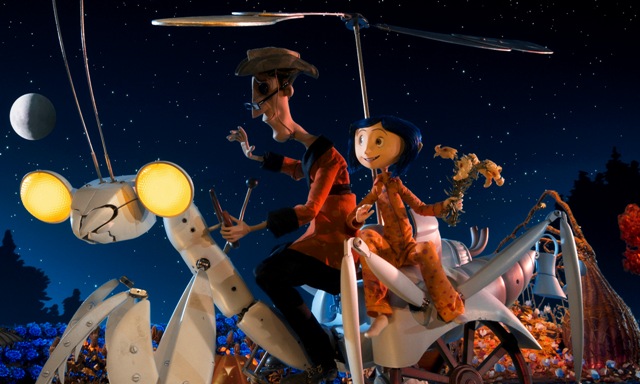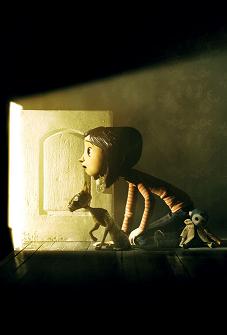What a simple, brilliant story, in any medium1: Coraline Jones, bored and feeling unloved, goes exploring in her new home and finds a small, secret door—and, through the door, a skewed reflection of the house and environs, inhabited by versions of her parents and neighbors who are more fun, more exotic, and much more focused on Coraline than anyone in her life seemed to be before. The only problem is that they all have black buttons in the place of their eyes, and if Coraline wants to stay, they say, she’ll have to sew the buttons in, too. When she decides she doesn’t want to stay well, that’s when Coraline discovers that her Other Mother doesn’t care quite as much about what Coraline wants as she claims she does.
Under Henry Selick’s meticulous direction and with the aid of an excellent cast of voice actors2, Neil Gaiman’s spare, precise novella is transformed into a beautifully intricate stop-motion spectacle that avoids slavish replication of the plot’s details while remaining largely faithful in tone and spirit to the book. Which is a good thing, of course, since Coraline the book felt like a classic from the moment it was released, and it wouldn’t be too much of a stretch to say that the film could become one, too.
Though, perhaps, their claims to classic status would come from different virtues. Gaiman’s novella offers a solid base to build from: the bravery and cleverness of its heroine, its astute understanding of the interconnected fears and desires of childhood, and its pitch-perfect evocation of resonant literary tropes and imagery (a questionably trustworthy feline guide, a secret portal, an inverted world, and Gaiman’s very own contribution to the indelible images of children’s literature, those worrying black buttons). State-of-the-art technology (wonderfully detailed puppetry and, if you see it in “Real3D,” a 3D experience that manages to be absorbing rather than annoying) and exceptional artistry allow Selick to reproduce these strengths while expanding the vision.
Where Gaiman’s sparseness hinted at the wonders in the Other Mother’s world and allowed imagination to fill in the blanks, Selick offers a profusion of marvels to amaze and delight. Accompanied by the enjoyably unsettling soundtrack and utilizing the 3D tech to the utmost, extended set-pieces like the Other Father touring Coraline on a mechanical mantis around his garden as it blooms riotously into a giant likeness of her face, or the elaborately choreographed performance of her alternate-world upstairs neighbor’s Jumping Mouse Circus, are pure sensory joy.

And when the otherworld shifts from turning-on-the-charm to turning-up-the-terror, the effects are up to the challenge of changing the experience from merely off-kilter to full-on threatening. As the miracles turn sour and the masks begin to crumble, Coraline learns the true meaning of the film’s tagline: “be careful what you wish for.”
The movie, perhaps necessarily for mass consumption, slightly conventionalizes the narrative of the novella. Certain changes and additions to the plot strip out some of the subtleties (her parents’ objectively awful behavior at the beginning), and add a hint of moralizing (there’s a suggestion that Coraline is at least partly to blame for her entrapment because she willfully disobeys her mother). Still, even if the movie is not as subversively strange or bone-deep disturbing as the book (which, for its part, remains one of the most intensely uncanny stories I can recall), it certainly creates an effectively creepy atmosphere. And I was quite gratified to see that Coraline had lost none of her smarts, guts, or resourcefulness in translation. Every victory she achieves is well-earned with a quick plan or act of real courage.
So while comparing it too much to the source material may be a sucker’s game (as such comparisons usually are), and a good way to ensure you enjoy it less than you otherwise might, the movie carves out its own worthy niche. Impressively, impeccably crafted all the way through, Coraline seems likely to endure as an exemplary visual experience with a compelling narrative, and any film this exuberantly inventive deserves such longevity. Though perhaps I should be clear—it first deserves to be seen in the theater.
Amusing endnote: the Ziegfeld theater, like all of Coraline’s “real world” neighbors, got her name wrong. According to the Zieg’s ticket, I paid $16.50 (3D is expensive, man) to watch a movie called “Caroline.”
1So far it’s reached three: book, graphic novel, and this film, not counting variations like the audiobook or non-3D cut of the movie.
2Including Dakota Fanning, Teri Hatcher, John Hodgman, Keith David, and the musical stylings of They Might Be Giants.











I saw the film yesterday, and your review is SPOT ON. Couldn’t agree more. I also thought your readers might like to know that they can get one-of-a-kind items from the film, including a Coraline doll, mice, and other cool stuff at a charity auction benefiting Starlight. (full disclosure, I work at Starlight!) but still! so cool: http://www.ebay.com/starlight
About the number of adaptations. Actually, it’s four. Mittiprickteatern (translates to “Bulls Eye Theatre” http://www.mittiprickteatern.se) in Sweden made Coraline into a play. See:

@AnnaPanna: And Stephin Merritt wrote words and music for an upcoming musical of it, too! [url]http://www.mcctheater.org/currentseason.html[/url]. I actually knew that, just forgot it while composing the post.
Good review, but IIRC, Coraline transgressing by disobeying her mother is straight out of the book. The only difference in that respect is the number of dreams before she disobeys her mother and goes to the otherworld in the flesh.
@@.-@: You know, what caused me to write that was that I recalled her parents simply being gone the first time she went back home in the book. So it seemed less likely to me that it was the “transgression” that made her and her family vulnerable, and more that the Beldam had power and influence in the real world in her own right, once the door was opened for her, no matter how or why it was opened.
But your comment made it click in my mind that the movie’s “dream episodes” were, in fact, literally just dreams, sent by the Beldam as non-physical influence to get Coraline to *actually* open the door. Somehow, I was processing them as actual visits to the otherworld previously. And that definitely minimizes this quibble, because the suggestion is no longer that the transgression was the problem, it was the act of opening the door in the waking, physical world that made her family vulnerable.
Oh, absolutely, it’s opening the door (in both book and movie) that -actually- gives the Belle Damme (I’m trying to remember; does the book actually spell out the nickname?) a means of entry. And until the physical key is turned in the physical lock, that’s not happening.
Mind, the transgression is an important trope; the flow of horror (or maybe just horrific fantasy?) typically involves rising tension, a transgression (typically, an incorrect choice), resulting catastrophe, and finally catharsis and resolution. The transgression is important, I think, because it makes the catastrophe follow logically (or emotionally) rather than having it be for no reason. If Coraline isn’t warned against the door (three times? Mother, Mice. Is there another warning? In the movie, there’s also Wyborn, of course), it feels unfair that bad things come from her going through it, whereas with the warnings, it is her that put things wrong and her responsibility to set things right.
I do have to wonder, with a slow but steady increase in 3d movies worth watching in 3d, if these are going to be a lifelin that keeps the theater alive — or if there are going to be setups one can use to watch “real3d” movies at home (polarized screen filters, maybe?)
There was also a puppet production in Ireland done by Púca puppets in 2006
Heres Neil blogging about it
@6: I think the book does spell out Beldam at some point – it’s a play on “Belle Damme,” yes, but I think it’s also a play on “bedlam.”
And I do think you’re right about transgression being an important part of it, but in the sense that Coraline made the incorrect choice to open and go through the door (the warnings made it a *foolish* choice as well). The incorrect choice was not specifically to go through after her mother had locked it again. In other words, when I misinterpreted it, it felt like the Beldam was given power by Coraline’s choice/disobediance itself, a sort of allegorical/moralizing fairy tale-type idea, instead of gaining that power through a material point of entry. I *like* the element of materiality – of, yes, this is not a dream, the horror is, in an important way, real – in the story. It makes it scarier, for me. And it also, it occurs to me, emphasizes that consequences follow from actions, not intentions. Nothing Coraline did made her *deserve* the experience she went through… she simply stumbled into something deeper than she could ever have known, and had to fight her way out.
(You know, I realize after I wrote this that I suppose I’m not exactly agreeing completely. I wouldn’t find it unfair if she opened the door without being warned, and bad things still happened. It’s not like kids could possibly be warned about every danger they might be exposed to; sometimes there are just bad things out there. The whole “the world is not fair” idea. But I do agree that the warnings work and round out the plot in the context of the book and movie, at least.)